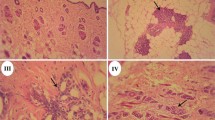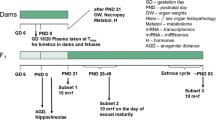Abstract.
Groups of five male and female Wistar rats were treated by gavage with 0, 0.01, 0.05 or 0.2 mg/kg body weight of the known synthetic estrogen ethinylestradiol for 28–32 days according to a modified enhanced OECD Test Guideline no. 407 in order to investigate which of the current and/or additional parameters would detect effects on the endocrine system reliably and sensitively and to provide data on intra-laboratory variability. Two identical studies (A and B) were run concurrently. The modified enhanced protocol requests the additional determination of triiodothyronine, thyroxine and thyroid-stimulating hormone (TSH), of the stage of the estrous cycle to ensure necropsy of all females in diestrus, of the number and morphology of cauda epididymal spermatozoa, and of additional organ weights (ovaries, uterus, thyroid, and male accessory reproductive organs), and histopathology of additional organs (pituitary, epididymides, coagulation glands, pancreas, and vagina). There were no treatment-related mortalities, clinical signs or changes in behavioral parameters. In male rats, 0.2 mg/kg was the maximum tolerated dose (MTD) resulting in reduced body weight gain. The only treatment-related alteration in hematological parameter was prolonged blood clotting time in high-dose females of both studies. Changes in clinical chemistry observed in study A were elevated alkaline phosphatase activity (high-dose females) and triglyceride levels (mid- and high-dose females and high-dose males). Changes in thyroid hormones and TSH of treated animals showed high variability with no clear dose-dependency, and could not be clearly related to estrogenic activity. In accordance to a suppression of the hypothalamic-pituitary-gonadal axis, decreased relative organ weights of the male accessory reproductive organs were obtained in both studies at the high dose. Corresponding histological changes were degeneration of the testicular germinal epithelium and atrophy of Leydig cells and of all accessory sex glands. Atrophy of the coagulating gland (study A) and seminal vesicles (study B) was also seen at 0.05 mg/kg. A marked increase in relative adrenal weight in male rats, accompanied by decreased vacuolization of zona fasciculata cells observed in both studies at the high dose seems to reflect an activation of the hypothalamic-pituitary-adrenal axis. The male mammary gland was sensitively affected. Increased numbers of small basophilic over large acidophilic cells indicated an estrogen-mediated feminisation and were detected at the low (study A) or mid dose (study B). Co-mitogenic properties of estrogens in rat liver were reflected by increased relative liver weights in females at the mid and high dose of study A and also at the high dose in study B. No treatment-related changes in endocrine organ weights were observed in treated females. Histological changes in the ovaries were increased numbers of apoptotic corpora lutea (from mid dose, study B) and of early stage follicles at the high dose in both studies. Classical direct estrogenic effects on the uterus, i.e. an increased height of luminal and glandular epithelium and increased granulocytic infiltration of the endometrium, were observed even at the low dose in both studies. Uterine findings occurring with a greater variability were dilation, squamous metaplasia of glands and thickened walls. Although females were necropsied in diestrus, as diagnosed by vaginal cytology, typical signs of estrogenic action in the vagina such as keratinization (indicative of estrus in normally cycling rats), mucification (indicative of proestrus), or thickened epithelia were observed in both studies even at the lowest dose. This unexpected discrepancy between vaginal cytology and vaginal and uterine morphology of treated females was considered to be treatment-related as it was not observed in the controls. Studies on liver enzymes that were performed outside the scope of the enhanced protocol showed that ethinylestradiol at 0.2 mg/kg decreased the activity of the sex-specific testosterone-dependent liver enzyme CYP2C11 in male rats. A simulation of doubling group size (to ten animals) by combining both studies did not increase the sensitivity of detection of endocrine-mediated effects above the level already obtained by histopathological examination of groups containing five animals. Only some of the enhancements to the current OECD Test Guideline no. 407 evaluated in this study (additional organs weights and additional histopathological investigations) were helpful in detecting the endocrine-mediated effects of ethinylestradiol, while other enhancements did not contribute towards this aim. Spermatology was completely insensitive at the MTD and measurement of thyroid hormones and TSH did not contribute to increased sensitivity. Vaginal cytology appeared to be an unreliable procedure for estrous cycle staging in estrogen-treated animals. Ongoing investigations, according to the modified version of the enhanced OECD Test Guideline no. 407 protocol, into the interference of ten compounds with the endocrine system by different mechanisms will result in the identification of the most appropriate enhancements.
Similar content being viewed by others
Author information
Authors and Affiliations
Additional information
Electronic Publication
Rights and permissions
About this article
Cite this article
Andrews, P., Freyberger, A., Hartmann, E. et al. Sensitive detection of the endocrine effects of the estrogen analogue ethinylestradiol using a modified enhanced subacute rat study protocol (OECD Test Guideline no. 407). Arch Toxicol 76, 194–202 (2002). https://doi.org/10.1007/s00204-002-0337-7
Received:
Accepted:
Issue Date:
DOI: https://doi.org/10.1007/s00204-002-0337-7




